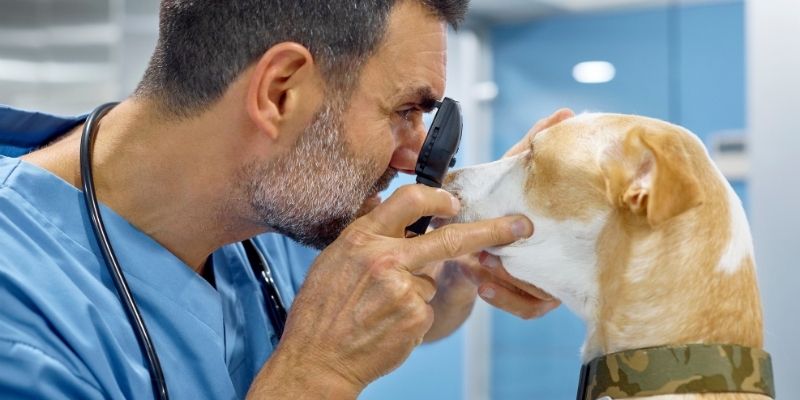One of the most common worries in canines is a dog’s red eyes. Dog’s eyes are sensitive just like ours and are susceptible to inflammation and irritation. If your dog has bloodshot eyes, it is normal for questions like, “why is my dog’s eye red?“, “Should I call the emergency ward?” to pop up in your mind, but the important thing here is to not panic. Read on to know what it means and why your dogs’ eyes are red.
Do you have a specific question about red eyes in dogs? Then use the table of contents below to jump to the most relevant section. And you can always go back by clicking on the black arrow in the right bottom corner of the page. Also, please note that some of the links in this article may be affiliate links. For more details, check the Disclosure section at the bottom of the page.
Here's what we'll cover:
Are dogs’ eyes supposed to be red?

Short answer: no! Long answer: The anatomy of a dog’s eyes is more or less the same as your own. The organ continuously adjusts to the environment. Light enters through the cornea and hits the retina. The information received is relayed to the brain to interpret. However, a noticeable difference among others is the existence of a third eyelid. The third eyelid or the nictitating membrane exists to protect your dog’s eyes from scratches and injuries.
Nevertheless, certain kinds of external irritants can damage the membrane and cause your dog to be more sensitive to disease and infection. Ultimately, it leaves your dog with red eyes. The conclusion here is that red-eye in a dog does not appear under normal circumstances where your dog is healthy. The appearance of red eyes signifies allergy, infection, or disease.

Why do dogs’ eyes get red?

Red eyes cause your dog’s eyes to appear inflamed. There can be several speculations as to why this inflammation occurs. Inflammation in both human eyes and dog eyes is non-specific; hence it is difficult to pinpoint a particular cause. In humans, the eye’s inflammation can be traced back to infection, allergy, trauma, or in more serious instances, underlying systemic diseases like an autoimmune disease. In dogs with red eyes, inflammation can be identified as a symptom of hyphema.
Hyphema is a condition that results in the accumulation of excess blood in eyelids as a result of high blood pressure, platelet disorders, and blunt force trauma. Another reason can be retinal vasculitis. It is a sight-threatening condition resulting from bacterial or viral infections or systemic autoimmune or inflammatory diseases. Inflammation causes vessels in the eyes to expand because of blood accumulation—this passive accumulation and inflammation cause dogs’ red eyes.

What causes red eyes in dogs?

There are several reasons why your dog has red eyes. Let us explore some of them together.
Conjunctivitis
Conjunctivitis is as common in dogs as it is in humans. Usually, it calls for medication and a few days of rest. Still, if left untreated, it may amount to vision impairment. Conjunctivitis or Pink eye can be an isolated disease or a symptom of an underlying illness. It occurs with the inflammation of the moist tissue that lines inner eyelids – the conjunctiva.
The most common symptoms are spasmodic blinking, redness, inflammation, and clear or murky discharge from the eyes.
There are a few different types of conjunctivitis; here is a quick list:
Allergy:
Does not spread easily. Causes include pollen, mold, perfume, powder, mites, and drugs. The only way to avoid it is to identify allergens and remove them from your pet’s vicinity.
Virus:
Spreads easily and takes a long time to heal. Caused by viruses like Canine Distemper. Viral diseases can prove fatal, which means staying up to date with vaccinations is necessary.
Bacteria:
This one is another contagious variety of pink eyes—for example, strep and staph infections.
Other causes:
Presence of foreign objects in the eye, environmental irritants, lid and lash diseases, Glaucoma and irritation from eye medications.
Note: Some breeds are more at risk of developing conjunctivitis. This includes brachycephalic or short-nosed breeds like Pugs, Shih Tzus, Boxers, and French Bulldogs.

Dry Eye

Scientifically known as Keratoconjunctivitis sicca, Dry eye refers to a condition wherein the tissues surrounding the cornea become dry and inflamed. Tears are released to lubricate the cornea to protect it from any debris or infectious agent. Still, in the presence of a condition that keeps the eyes from producing enough tear film, dry eyes occur.
Here are some of the common causes of dry eye:
● Poor immune system and immune-mediated diseases
● Systemic diseases
Cherry Eye
Cherry eyes in dogs are very common. The third eyelid or the nictitating membrane in dogs is attached to the lower rim of the inner eye by a weak fibrous attachment. This makes it easy for the gland to ‘pop out’ or prolapse. Its red and swollen appearance resembles a cherry and hence the name cherry eye. A dog’s cherry eye usually requires surgical treatment.
Corneal lacerations

Any foreign object that penetrates the cornea of your dog’s eyes presents a grave risk to its vision. Consider that a sharp blade of grass or a prickly thorn pokes your canine’s eyes. It can cause irritation, lens trauma, and injury that leads to corneal lacerations. If your dog has red eyes and you spot swelling or cataract-like symptoms, it may be indicative of lacerations.

What if the dog has one red eye only?
Any redness is a sign that trouble is afoot. Whether it appears in one eye or both, your dog has red eyes only in the event of irritation, inflammation, disease, and injury. Moreover, conjunctivitis is known to affect one eye at a time.

How about the redness around dog eyes?
Among the various causes of red eyes listed above, some appear different from others. The Cherry eye is the most prominent as it is a piece of red mass in the eye. If you notice redness around a dog’s eyes, the causes can be conjunctivitis, dry eye, or corneal damage. Instead of self-diagnosing, visit a vet for a clear diagnosis.

Why are my puppy’s eyes red?
Just like human infants, puppies are much more susceptible to injuries, allergies, and diseases. There is a specific kind of conjunctivitis, called neonatal conjunctivitis, that only occurs in newborns. It results in infections and sticky eyelids due to the accumulation of discharge. Therefore, if you spot redness in your puppy’s eyes, remember that it is no different than red eyes in an adult dog.

Red-eye in dogs treatment

If your dog’s eye is red, your immediate response should be to book an appointment with the veterinarian. Prompt action is crucial to prevent any further damage. Do not perform self-diagnosis under any circumstances.
Your veterinarian will conduct a complete physical test, including blood work and urinalysis, to detect the possibility of an underlying disease. An x-ray is likely to be conducted to inspect the chest and abdominal region for infection.
A detailed ophthalmologic examination will be conducted to identify damages. In the case of lacerations and damages, they will verify it using dye on the cornea. If your veterinarian suspects dry eyes, they will perform a Schirmer tear test to test the level of tear being produced. In the case of conjunctivitis, they will perform a cytologic examination.
The treatment prescribed will depend on the diagnosis made by your doctor. For cherry eyes, surgical procedures are necessary. For conjunctivitis, antibiotics and other medications will be prescribed. These medications will be either eye drops or ointments.
All in all, our canine friends are prone to allergies, infections, injuries, and diseases that can have grave consequences for their health. For a dog’s red eyes, several causes can be identified. With this comprehensive guide, bid all your worries adieu and move towards a healthier life for your dog.
Thanks for the blog graphics: Canva.com

Thanks for the blog graphics: Canva.com
Doghint.com is a participant of several affiliate programs. The list includes (but not limited to) the following: VigLink, Refersion, ShareASale, and Amazon Services LLC Associates Program, an affiliate advertising program designed to provide a mean for us to earn fees by linking to Amazon.com and affiliated sites. Doghint.com does not intend to provide veterinary advice. All published articles are meant for informational purposes only and not substitute the professional veterinary consultation.


